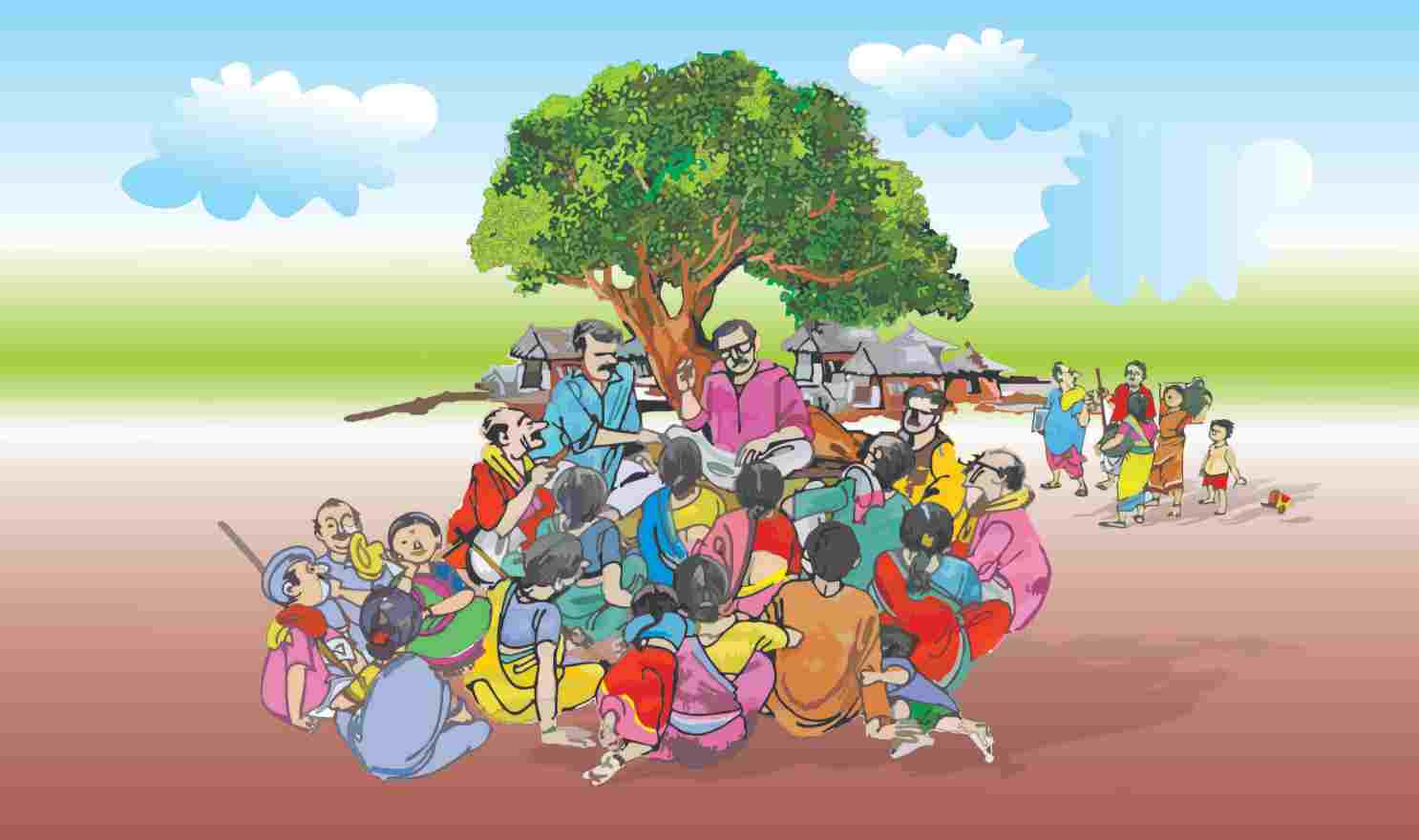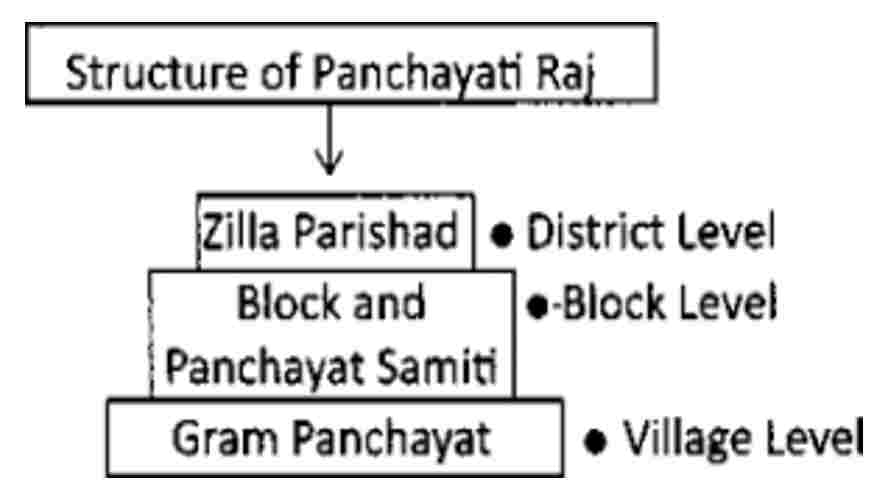
“When the panchayat raj is established, public opinion will do what violence can never do”
– Mahatma Gandhi.
Evolution Of The Panchayat System
- The idea of local self-governance in India has existed since ancient times. Local governance was also mentioned in the Kautilya’s Arthashastra. The development of local governance was also given importance during British rule. Lord Ripon is considered the father of local governance in India as he played a very important role in this context.

After the attainment of independence,
1. Community Development Programme:-
- It was started in 1952, by the government with the aim of generating interest among rural people of the country toward national plans for economic planning and social justice. But this program could not be successful.
2. Balwant Rai Mehta Committee:-
- This committee was formed in 1957 to review projects and suggest measures for better working of the Community Development Programme. The committee submitted its report in November 1957, in which several recommendations were made by committee : –
- Three-tier Panchayati Raj system: Gram Panchayat, Panchayat Samiti, and Zila Parishad.
- Directly elected representatives constitute the gram panchayat and indirectly elected representatives to constitute the Panchayat Samiti and Zila Parishad.
- Planning and development are the primary objectives of the Panchayati Raj system.
- Panchayat Samiti should be the executive body and Zila Parishad will act as the advisory and supervisory body.
- All development works at the village level are to be done by the panchayat.
- It also requested provisioning resources so as to help them discharge their duties and responsibilities.
- The report recommended that the Panchayati Raj institutions can play a substantial role in community development programs throughout the country. It made many more recommendations to local institutions. The first Panchayati raj was established in the Nagaur district of Rajasthan on 2 October 1959 after the recommendations by the committee but still, most of the states had not made significant efforts to empower the panchayats. So, in 1977, the Janta party formed the Ashok Mehta Committee.
3. Ashok Mehta Committee:-
- The key recommendations made by the committee are:
- The three-tier system should be replaced with a two-tier system: Zila Parishad (district level) and the Mandal Panchayat (a group of villages).
- The state government should not interfere in the function of panchayat institutions,
- Zila Parishad should be the executive body and responsible for planning at the district level.
- The institutions (Zila Parishad and the Mandal Panchayat) have compulsory taxation powers to mobilize their own financial resources.
- Reservation is on the basis of the population of the scheduled tribe and scheduled caste.
- Panchayat elections should be conducted by the Chief Election Commissioner of the state.
Several other committees were formed like G V K Rao Committee, the M. Singhvi committee in 1986, Thangun Committee in 1988, and Gadgil Committee in 1988.
73rd Constitutional Amendment Act
The turning point came in 1992 when the 73rd constitutional amendment related to the Panchayat system was introduced in Parliament 1992, which was passed in the Parliament in 1993.
This act added a new Part-IX to the Indian Constitution. This section is titled ‘The Panchayats’ and it contains provisions from Articles 243 to 243 O.
Furthermore, the act added a new Eleventh Schedule to the Constitution. This schedule includes 29 panchayat functional items. It is concerned with Article 243-G.

Features of the 73rd amendment act:-
The three-tier system of the panchayat was provided in every state i.e., gram panchayat at a lower level, Panchayat Samiti at the intermediate, and Zila Parishad at the district level which brought uniformity in the structure of Panchayati Raj institutions throughout the country.
The members of Panchayats at the village, intermediate, and district levels shall be elected directly by the people whereas the chairman of the Panchayat at the intermediate and district level shall be elected indirectly from amongst the elected members.
Reservation of seats for SC and ST is provided in every panchayat in the proportion to their population.
Reservation of 1/3rd of the total number of seats is also provided for women.
Panchayats have been provided for a five-year term of office at every level. It can however be dissolved before the completion of its term.
The conduct of elections to the Panchayats shall also be handled by the state election commission.
The finance commission is constituted by the governor to review the financial position of the Panchayats every 5 years. It also determines the taxes, duties, tolls, and fees that may be assigned to Panchayats.
- Gram Sabha was the foundation of the Panchayati Raj System which consisted of the people registered in the electoral rolls of the village within the area of the Panchayat.
Structure Of The Panchayati System

1. Gram Panchayat:-
It is the first tier of the Panchayati Raj system. It is the executive body of Gram Sabha. All those residents of a village in the Gram Sabha are a member who is 18 years old age and have their name on the voter list. The size and term of Gram Panchayat vary from state to state. One-third of seats have been reserved for women and one-third for SCs and STs. The tenure of Gram Panchayat has been fixed for 5 years by the 73rd amendment.
The Sarpanch is elected for a period of five years. Gram Panchayat is governed by the elected body and administration. The secretary is normally in charge of the administrative duties of the Gram Panchayat.
Functions of Gram Panchayat
- Construction and Maintenance of Public Facilities
- Levying and collecting local taxes
- Executing government schemes related to generating employment in the village
- Plantation of roadsides.
- Provision of a better water financing system.
2. Panchayat Samiti:-
Panchayat Samiti is the intermediate level in Panchayati Raj Institutions. The Panchayat Samiti acts as the link between Gram Panchayat and District Panchayat. Panchayat Samiti is considered to be the most important institution of the Panchayat structure as all the rural level work is done in the name of Panchayat Samiti.
The Panchayat Samiti elects a Chairman and a Vice-chairman from among its member. One-third of seats have been reserved for women while a third seat is reserved for SCs and STs.
Functions of Panchayat Samiti: –
- Providing clean drinking water.
- Maintaining cleanliness of roads and arranging for the disposal of waste.
- Helping the farmers improve agriculture and livestock.
- Provide primary education.
- Presenting the annual plan budget of the Panchayat Samiti.
- Formulation and implementation of poverty alleviation projects.
3. Zila Parishad:-
- The District Council or Zilla Parishad is the third tier of the Panchayati Raj system. There is a District Council in each district. The primary objective of establishing the third tier of the government is to increase democratic participation, better articulate local needs, and priorities, and ensure more efficient use of local resources along with greater accountability and transparency.
Functions of Zila Parishad: –
- It is responsible for giving proper advice to Gram Panchayats and Block Samitis & assist in their functioning.
- It can give suggestions to the government regarding the rural development of the district.
- Performs the task of land reforms, irrigation sources, and land conservation.
- In accordance with the Block Samiti, it makes the developmental plans for the whole district.
- Coordinates the activities of the Panchayats in all its developmental activities, such as minor irrigation works, vocational and industrial schools, village industries, sanitation, and public health among others.
Significance Of The Panchayati Raj System

Earlier there was no uniform pattern for local governance, it remained under the state list with limited power and functions but as the result of the 73rd amendment act, local governance became self-reliant and independent.
Grassroots Participation = The act deepens the democracy at the grassroots level and encourages the local institution to deal with their own affairs and find an appropriate solution.
Decentralization of activities, reassigning of central officials to the local level, enhances the knowledge and sensitivity of officials to local issues, and facilitates close interaction between government and citizens.

Increases political awareness among people making them aware of their rights and responsibilities and demanding equal rights.
Earlier, local bodies were considered ‘agents’ of state government, dependent on the state. But the act has enabled the local governments to make decisions, providing them with administrative and financial autonomy.
Women’s Empowerment = increases women’s participation in politics by providing them reservation in the local bodies, not as the member but also as a leader, elevating women’s status from subjugated to self-reliant.
Increasing efficiency, transparency, and accountability in governance at the local level by assigning power to the local level at the grassroots level. Ultimately, deepening democracy in the country.
Challenges To Panchayati Raj System
There is no clarity about the relationship between Panchayati Raj Institutions and the administrative organization of the government. It is also clear that the administration has dual responsibility i.e., towards state departments and towards Panchayati Raj Institutions. This has resulted in a lot of confusion and complications.
While establishing Panchayati Raj bodies, no uniform pattern is adopted for creating units and identifying the units of planning and development. This may not be a cause for failure but the structures that have been adopted by various state governments are just not capable of performing the role that is expected of them.
The most important problem faced by the Panchayati Raj Institutions is regarding finances. The local economy is very weak. It means, the Panchayati Raj Institutions have a very limited scope to impose taxes in their jurisdiction.
The existing socio-economic structure of the Indian society is a major factor that is responsible for the limited success of Panchayati Raj Institutions.
Although reservations of seats at the different levels have been made in some states the reservation concept has not been effectively adopted.
The elite and the so-called higher levels generally do not provide political support to strengthen the democratic process at the grassroots levels. The Members of Parliament and State Legislatures always felt that the Panchayati Raj leadership would emerge as a threat to their position in their respective constituencies.
National Panchayati Raj Day (24th April)

- Celebrated every year on April 24 to raise awareness about the panchayats and gram sabha along with local self-governments in rural India. The day was first celebrated in April 2010 making it one of the most important days in Indian history.
Panchayat Web Series

- Panchayat is a Hindi drama series based on the Panchayati system in the remote village Phulera of Uttar Pradesh. The series was shot in a real panchayat office located in village Mahodiya of district Sehore Madhya Pradesh. The series deals with the experiences of an engineering graduate boy from a city who is not familiar with village cultures, completing his graduation gets a low-salary job as a secretary of a Gram panchayat in a remote village called Phulera in Uttar Pradesh.
- The writer of the series Chandan Kumar said that the series deals with the real issue in society. “You see the culture of Pradhanpati where the husband of a woman Pradhan holding the real power is still prevalent. And it’s not just restricted to villages. It happens in cities too. So, we wanted to highlight those realities. My director Deepak Mishra and I had the concept clear. He also comes from Varanasi and he too understands the ground reality well. So, it came easy to us.”
Statistical Data On Panchayati System
According to the Ministry of Panchayati Raj, Government of India.
S.no | Unit | Numbers |
1 | Number of PRIs in the country | 2,60,512 |
2 | Number of Village Panchayats | 2,53, 268 |
3 | Number of Intermediate Panchayats | 6,614 |
4 | Number of District Panchayats | 360 |
5 | Number of Elected Members of PRIs | 31.00 lakh (approx.) |
6 | Number of Elected Women Representatives | 13.75 lakh (approx.) |
Top 13 Interesting Facts About Panchayat Raj System
In 1993, the 73rd Constitutional Amendment came into force and became a turning point in the local government which led to the formation of the Panchayati Raj system in India.
Rajasthan became the first state to implement the system in the country in 1959 in the Nagaur district. The scheme was inaugurated by the first Prime Minister of India, Pandit Jawaharlal Nehru.
Balwant Rai Mehta is credited for pioneering the concept of the Panchayati Raj in India known as the ‘Father of Panchayati Raj’.
SVAMITVA (Survey of Villages and Mapping with Improvised Technology in Village Areas) was launched by Prime Minister Narendra Modi on National Panchayati Raj Day.
Local self-government institutions received a boost with the appointment of the Royal Commission on centralization in 1907 under the Chairmanship of C.E.H. Hobhouse. The commission recognized the importance of panchayats at the village level.
Local governance has been in focus even in ancient times, it was mentioned in the Kautilya’s Arthashastra.
The most important committees on local governance are Hanumantha Rao Committee (1983), G.V.K. Rao Committee (1985), L.M.Singhvi Committee (1986) and the Sarkaria Commission on Centre-State relations (1988), P.K. Thungan Committee (1989), and Harlal Singh Kharra Committee (1990).
The Panchayati Raj systems are present in all the states of India, except Nagaland, Meghalaya, and Mizoram, in all Union Territories except Delhi; and certain other areas.
As a result of the elections of the Panchayats in the States there are about 3.4 million elected representatives at all levels of the Panchayat. A large number of them are new entrants, particularly from weaker sections and women.
Mahatma Gandhi advocated Panchayati Raj as the foundation of India’s political system, as a decentralized form of government in which each village would be responsible for its own affairs.
Under the 15th Finance Commission for the period 2021-26, Rs. 2,36,805 Crore has been recommended for rural local bodies (RLBs)/ panchayats.
This year in Azadi Ka Amrit Mahotsav, NPRD is very special. Ministry of Panchayati Raj, Government of India has been incentivizing the best performing Panchayats recommended by the State Governments/UT Administrations since 2011-12. During the National Panchayat Raj Day event, awards are being given to the best performing Panchayats.
As a result of the election to PRIs in States/Union Territories, 2,27,698 Panchayats at the village level, 5906 Panchayats at the intermediate level, and 474 Panchayats at the district level have been constituted in the country.







